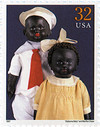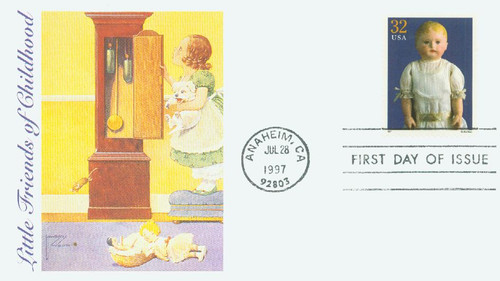
# 3151a - 1997 32c Classic American Dolls: "Alabama Baby" and Martha Chase Doll
US #3151a
1997 “Alabama Baby” & Martha Chase – Classic American Dolls
- Pictures the American Dolls “Alabama Baby” and “Martha Chase,” designed by Ella Smith and Martha Chase, respectively.
- Part of the Classic American Dolls set – the first time photographs were used instead of paintings or drawings for a large US set with different stamp designs
Stamp Category: Commemorative
Set: Classic American Dolls
Value: 32¢, First Class Mail Rate
First Day of Issue: July 28, 1997
First Day City: Anaheim, California
Quantity Issued: 105,000,000
Printed by: Printed for Ashton Potter (USA) Ltd. by Sterling Sommer of Tonawanda, New York
Printing Method: Offset
Format: Panes of 15 (Vertical, 5 across, 3 down)
Perforations: 10.9 by 11.1
Tagging: Large tagging block over all 20 stamps, covering the stamps to the edges
Why the stamp was issued: To commemorate the American dolls “Alabama Baby” and “Martha Chase.”
About the stamp design: The stamp pictures photographs of the two dolls against a blue paper background.
First Day City: The First Day of Issue Ceremony was held during the annual membership meeting of the United Federation of Doll Clubs at the Anaheim Hilton and Towers Hotel in Anaheim, California.
About the Classic American Dolls set: The USPS issued the stamps to commemorate American dolls that “reflect the tradition, heritage, culture, and artistic style from various geographical regions of this country.”
Each stamp design pictures a photograph by Sally Andersen-Bruce. Each doll or pair of dolls is shown in front of a blue paper background, tying the stamp designs together. The names of each doll are printed in small type below the bottom frameline of each stamp, across from the 1997 year date. They’re also listed in the horizontal selvage at the bottom of the pane of 15.
The set marked the first time photographs were used instead of paintings or drawings for a large US set with different stamp designs.
History the stamp represents: Advertised as “The Alabama Indestructible Doll,” the Alabama Baby, as it came to be called, had its beginnings when Ella Smith repaired a bisque doll for a neighbor’s child and realized the need for a doll that was unbreakable. Eventually, a factory worker claimed a delivery truck ran over one of her cloth dolls and never even cracked the paint.
Made with soft cloth bodies, the dolls had stiffened fabric heads with molded and painted features. Early Alabama Babies were originally marked on the stomach with the firm’s name and a date or number. And since they were stuffed from the top of their heads, the dolls can be easily distinguished by their stitched circular crowns. Ella Smith’s dolls were not only durable, but also extremely popular. In one year alone, her small factory in Roanoke, Alabama, reportedly produced as many as 8,000 dolls. Not content with her initial success, she continually sought to improve her dolls, applying for five patents starting in 1905.
Black Alabama Babies, such as the one shown on this stamp, are extremely rare and valuable. Black models of dolls were occasionally produced for black children, but white children also owned and loved the dolls. The little boy on the front poses for a 1920s photograph with his black composition doll.
US #3151a
1997 “Alabama Baby” & Martha Chase – Classic American Dolls
- Pictures the American Dolls “Alabama Baby” and “Martha Chase,” designed by Ella Smith and Martha Chase, respectively.
- Part of the Classic American Dolls set – the first time photographs were used instead of paintings or drawings for a large US set with different stamp designs
Stamp Category: Commemorative
Set: Classic American Dolls
Value: 32¢, First Class Mail Rate
First Day of Issue: July 28, 1997
First Day City: Anaheim, California
Quantity Issued: 105,000,000
Printed by: Printed for Ashton Potter (USA) Ltd. by Sterling Sommer of Tonawanda, New York
Printing Method: Offset
Format: Panes of 15 (Vertical, 5 across, 3 down)
Perforations: 10.9 by 11.1
Tagging: Large tagging block over all 20 stamps, covering the stamps to the edges
Why the stamp was issued: To commemorate the American dolls “Alabama Baby” and “Martha Chase.”
About the stamp design: The stamp pictures photographs of the two dolls against a blue paper background.
First Day City: The First Day of Issue Ceremony was held during the annual membership meeting of the United Federation of Doll Clubs at the Anaheim Hilton and Towers Hotel in Anaheim, California.
About the Classic American Dolls set: The USPS issued the stamps to commemorate American dolls that “reflect the tradition, heritage, culture, and artistic style from various geographical regions of this country.”
Each stamp design pictures a photograph by Sally Andersen-Bruce. Each doll or pair of dolls is shown in front of a blue paper background, tying the stamp designs together. The names of each doll are printed in small type below the bottom frameline of each stamp, across from the 1997 year date. They’re also listed in the horizontal selvage at the bottom of the pane of 15.
The set marked the first time photographs were used instead of paintings or drawings for a large US set with different stamp designs.
History the stamp represents: Advertised as “The Alabama Indestructible Doll,” the Alabama Baby, as it came to be called, had its beginnings when Ella Smith repaired a bisque doll for a neighbor’s child and realized the need for a doll that was unbreakable. Eventually, a factory worker claimed a delivery truck ran over one of her cloth dolls and never even cracked the paint.
Made with soft cloth bodies, the dolls had stiffened fabric heads with molded and painted features. Early Alabama Babies were originally marked on the stomach with the firm’s name and a date or number. And since they were stuffed from the top of their heads, the dolls can be easily distinguished by their stitched circular crowns. Ella Smith’s dolls were not only durable, but also extremely popular. In one year alone, her small factory in Roanoke, Alabama, reportedly produced as many as 8,000 dolls. Not content with her initial success, she continually sought to improve her dolls, applying for five patents starting in 1905.
Black Alabama Babies, such as the one shown on this stamp, are extremely rare and valuable. Black models of dolls were occasionally produced for black children, but white children also owned and loved the dolls. The little boy on the front poses for a 1920s photograph with his black composition doll.










